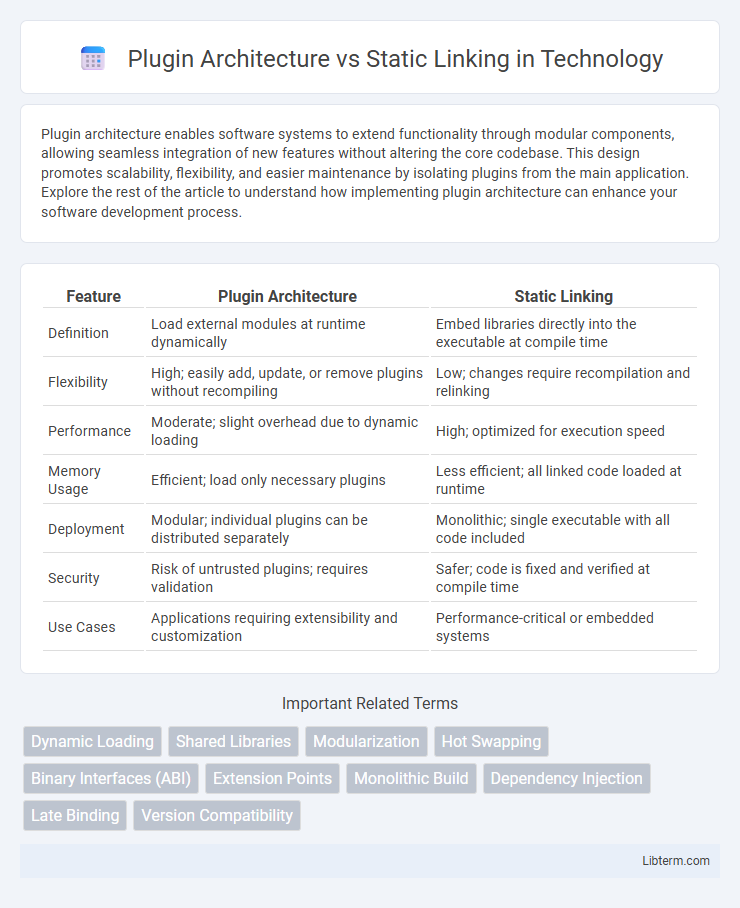Plugin architecture enables software systems to extend functionality through modular components, allowing seamless integration of new features without altering the core codebase. This design promotes scalability, flexibility, and easier maintenance by isolating plugins from the main application. Explore the rest of the article to understand how implementing plugin architecture can enhance your software development process.
Table of Comparison
| Feature | Plugin Architecture | Static Linking |
|---|---|---|
| Definition | Load external modules at runtime dynamically | Embed libraries directly into the executable at compile time |
| Flexibility | High; easily add, update, or remove plugins without recompiling | Low; changes require recompilation and relinking |
| Performance | Moderate; slight overhead due to dynamic loading | High; optimized for execution speed |
| Memory Usage | Efficient; load only necessary plugins | Less efficient; all linked code loaded at runtime |
| Deployment | Modular; individual plugins can be distributed separately | Monolithic; single executable with all code included |
| Security | Risk of untrusted plugins; requires validation | Safer; code is fixed and verified at compile time |
| Use Cases | Applications requiring extensibility and customization | Performance-critical or embedded systems |
Introduction to Plugin Architecture and Static Linking
Plugin architecture allows software systems to extend functionality dynamically by loading external modules at runtime, enabling flexible updates and customization without recompiling the core application. Static linking involves incorporating all necessary libraries and modules into a single executable at compile time, ensuring faster execution and simplified deployment but limiting post-compilation modifications. Understanding these two approaches is critical for developers aiming to balance extensibility, performance, and maintenance in software design.
Core Concepts: Definition and Differences
Plugin architecture enables dynamic loading and extension of software functionality at runtime through separate modules, enhancing flexibility and modularity. Static linking incorporates all required libraries and modules directly into the executable during compile time, resulting in a self-contained and often faster application but with less adaptability. The key difference lies in plugin architecture's ability to update or add features without recompilation, while static linking offers simplicity and performance at the cost of extensibility.
Flexibility and Extensibility Comparison
Plugin architecture enhances flexibility by allowing dynamic loading and unloading of modules at runtime, enabling applications to adapt and expand without recompilation. Static linking, while offering performance benefits and simpler deployment, limits extensibility due to the monolithic nature of the executable, requiring full rebuilds for updates. The modular design of plugin systems supports easier maintenance and scalability, making them preferable for software requiring frequent feature additions or customization.
Performance Implications
Plugin architecture enables runtime loading and unloading of modules, which can introduce overhead due to dynamic linking and indirect function calls, potentially reducing execution speed compared to static linking. Static linking combines all code into a single executable, allowing for better compiler optimizations and faster function calls, resulting in improved runtime performance. However, plugin systems offer greater flexibility at the cost of increased memory usage and latency during module initialization.
Security Considerations
Plugin architecture enhances security by isolating components, reducing the risk of full application compromise if a plugin is exploited, whereas static linking embeds all code into a single binary, increasing the attack surface. Plugins can be sandboxed and updated independently, allowing for quicker patch deployment and mitigating vulnerabilities without rebuilding the whole system. Static linking simplifies code integrity verification but limits flexibility and can delay security updates, potentially exposing the application to prolonged threats.
Deployment and Maintenance Challenges
Plugin architecture enables dynamic loading and unloading of modules, significantly simplifying deployment by allowing updates and patches without restarting the entire application. Static linking embeds all code into a single executable, leading to larger file sizes and requiring full recompilation and redeployment for any change, thus increasing maintenance complexity. The modular nature of plugin systems facilitates easier debugging and scalability, whereas static linking can complicate maintenance due to tightly coupled components and reduced flexibility.
Use Cases: When to Choose Plugin Architecture
Plugin architecture excels in applications requiring modularity, extensibility, and dynamic feature updates, such as content management systems, IDEs, and gaming platforms. It supports third-party integrations, allowing developers to add or update functionalities without modifying the core application or recompiling code. This architecture is ideal for environments with frequent updates, multiple user customizations, or scalable feature sets that demand flexibility and minimal downtime.
Use Cases: When to Prefer Static Linking
Static linking is preferred in embedded systems and environments where reducing runtime dependencies is critical for reliability and performance. Applications requiring fast startup times and simplified deployment, such as command-line tools or standalone executables, benefit from static linking by bundling all necessary libraries directly into the binary. Security-sensitive software often uses static linking to minimize external attack surfaces and ensure consistent library versions.
Real-World Examples and Case Studies
Plugin architecture enhances software flexibility by allowing dynamic loading of modules, as demonstrated by Adobe Photoshop's extensive plugin ecosystem that supports real-time feature updates without recompiling the core application. In contrast, static linking, used in embedded systems like automotive control units, ensures performance optimization and reliability by incorporating all necessary libraries into a single executable, reducing runtime dependencies. Case studies from Microsoft Office reveal that plugin architectures promote extensibility and third-party integration, while Linux kernel builds rely on static linking for stable core performance and security.
Conclusion: Choosing the Right Approach
Choosing between plugin architecture and static linking depends on the application's flexibility and performance requirements. Plugin architecture offers modularity and easier updates by loading components dynamically at runtime, ideal for extensible software environments. Static linking ensures faster execution and better reliability by integrating all code during compilation, making it suitable for performance-critical or standalone applications.
Plugin Architecture Infographic

 libterm.com
libterm.com